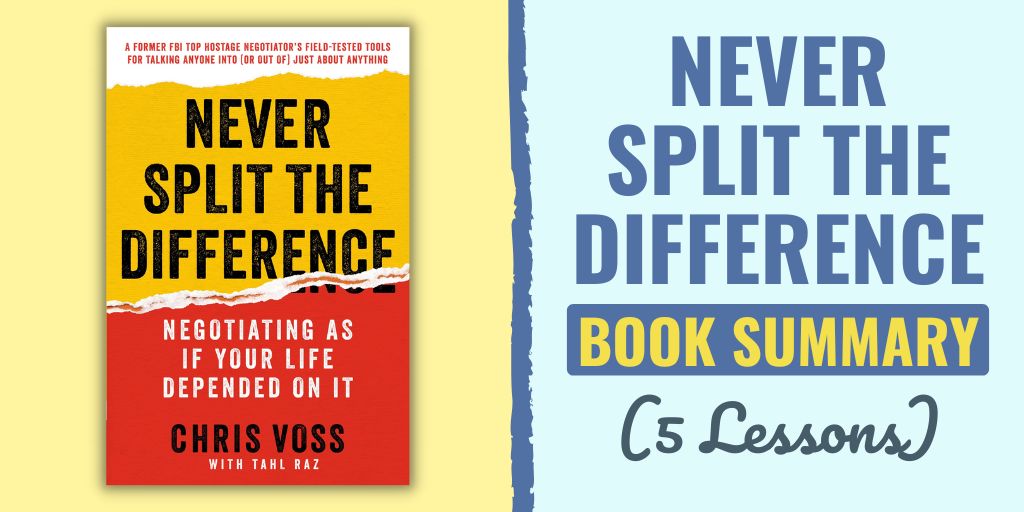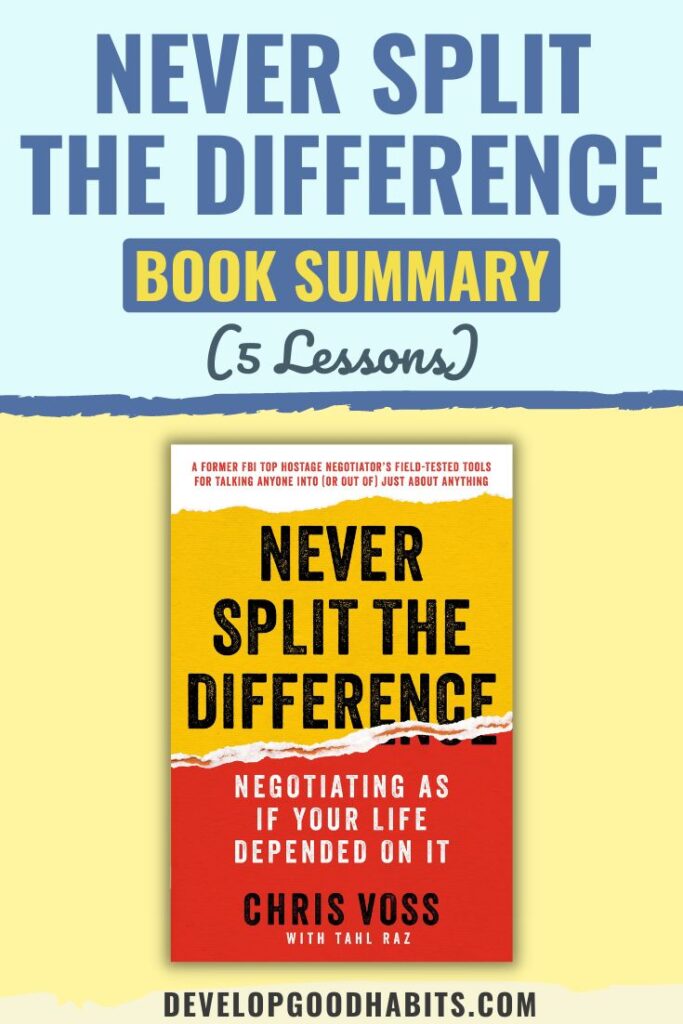If you're looking to improve your negotiation skills and gain confidence at the bargaining table, “Never Split the Difference” by Chris Voss and Tahl Raz is the perfect book for you.
Throughout the book, the authors emphasize the importance of understanding and leveraging emotions in negotiations. You'll learn practical tools and approaches like the “Accusation Audit,” “The Calibrated Questions,” and the “Ackerman model,” all aimed at maximizing your negotiation outcomes.
The authors draw from both personal experience (Christopher Voss’ years spent as an FBI hostage negotiator) and Tahl Razz’s insights into how this knowledge can be applied to our personal lives, careers, and businesses.
Now, if you’d like to check out the book, you can read it on your Kindle, get a print copy, or listen to the audiobook.
Lesson 1: The Authors
If you’re going to improve your negotiation skills, you’re going to want to learn from the best. One thing that sets this book apart is in how the authors (Christopher Voss and Tahl Raz) complement each other.
Let’s learn a little more about them.
Christopher Voss
Christopher Voss is a former international FBI hostage negotiator whose successful tactics were based on years of experience in high-stakes situations. His unique approach to negotiation is what makes his advice in “Never Split the Difference” so valuable.
During his time as an FBI negotiator, Voss developed a keen understanding of human behavior and the psychology behind effective communication.
Through this unique experience, Voss generated effective strategies that are useful not only in life-or-death situations but also in everyday life and business negotiations.
Tahl Raz
Tahl Raz is an award-winning journalist and co-author of “Never Split the Difference.” As a writer and speaker, Raz has always been passionate about exploring the intersection of business, social science, and human behavior. This interest led him to collaborate with Voss on this groundbreaking book.
Raz's journalistic experience and talent for storytelling are evident in the engaging way that “Never Split the Difference” is written. His ability to simplify complex concepts and present them in a relatable manner has undoubtedly contributed to the book's success.
Lesson 2: The Key Concepts
In this section, we’ll look into the key concepts and principles that form the backbone of “Never Split the Difference.” Understanding these will give you all the background knowledge you need to get the most out of the book.
Starting with…
Mirroring
Mirroring is a powerful technique where you repeat the last few words your counterpart said to encourage them to keep talking and reveal more information.
This allows you to better understand their needs and establish rapport. Remember to use an inquisitive tone and show genuine interest.
Tactical Empathy
Tactical empathy involves understanding and validating the emotions and perspectives of your negotiation counterpart. By doing so, you create a safe environment for a meaningful dialogue. Here's how you can practice tactical empathy:
- Listen actively to your counterpart's words and tone.
- Acknowledge their emotions and perspective.
- Ask open-ended questions to prompt further discussion.
Accusation Audit
Perform an accusation audit by addressing any negative expectations your counterpart may have about you. By addressing these concerns upfront, you reduce tension and gain their trust. To complete an accusation audit:
- Identify potential negative expectations.
- Address them candidly and sincerely.
The 7-38-55 Rule
The 7-38-55 rule states that communication is comprised of 7% words, 38% tone of voice, and 55% body language.
To improve your negotiation success, focus on non-verbal cues and your tone, as they play a significant role in how your message is received.
The Pinocchio Effect
The Pinocchio Effect refers to the idea that people tend to use more words when lying. Pay attention to excessive or unnecessary language during negotiations, as it may indicate deception or an attempt to manipulate.
Bend Their Reality
To bend your counterpart's reality, you must establish your expertise, competence, and confidence in the negotiation.
Use assertive language, maintain a focused demeanor, and demonstrate your understanding of their situation. By doing so, you become more influential and persuasive.
No Deal is Better Than a Bad Deal
Remember that no deal is better than a bad deal. Be willing to walk away from a negotiation that doesn't serve your best interests. Know your priorities, establish your limits, and stand firm when faced with unfavorable terms.
By applying these key concepts and principles, you can improve your negotiation skills and increase your success in achieving favorable outcomes.
Want to know what the benefits of having an accountability partner? Check out our video:
Lesson 3: Negotiation Strategies
Chris Voss and Tahl Raz share various negotiation strategies to help you become more effective and persuasive in your personal and professional life. This section highlights some key strategies mentioned in the book.
Establishing Rapport
Building rapport is crucial for successful negotiations. To do this, you must listen carefully to the other party, make them feel understood, and acknowledge their emotions.
Display genuine curiosity about their perspective and use mirroring techniques, such as repeating the last few words they said, to show that you're engaged in the conversation.
Creating a Collaborative Atmosphere
Negotiations are more effective when both parties work together towards a common goal. To create a collaborative atmosphere, first establish trust and rapport.
Then, emphasize shared interests and focus on the problem you're solving together, rather than positioning yourselves as opponents. An atmosphere of cooperation increases the likelihood of achieving a mutually satisfactory outcome.
Asking Calibrated Questions
Calibrated questions are open-ended questions designed to gather information, clarify positions, or prompt the other party to come up with a solution. Examples of calibrated questions include:
- How can we make this work?
- What about this situation isn't working for you?
These types of questions help shift the focus away from demands and ultimatums, encouraging creative problem-solving and collaboration.
Use the Ackerman Bargaining System
The Ackerman Bargaining System is a structured approach to negotiations, designed to reach an agreement while minimizing the risk of an impasse. Here's a brief overview of the steps:
- Set your target price.
- Calculate your first offer using a generous discount (typically 65% of the target price).
- Use calibrated questions and listen carefully to gather more information and gain leverage.
- Incrementally increase your offer using predetermined percentages (e.g., 85%, 95%, and 100% of the target price).
- Add a non-monetary concession to the final offer, making the other party feel like they've achieved a win.
By following these negotiation strategies from Never Split the Difference, you'll be better equipped to navigate high-stakes situations and achieve your desired outcomes while maintaining positive relationships with the people involved.
Lesson 4: Practical Applications for Personal Life
Applying the tactics from the book can help you navigate various situations.
For example, when buying a car, you can use the “Accusation Audit” by addressing the salesperson's likely concerns, such as wanting a fair deal. By addressing this, you create trust and a sense of cooperation.
Another personal life scenario could be negotiating with your children. Never Split the Difference suggests using the “Tactical Empathy” technique by validating their emotions while keeping your goals in mind. By understanding their perspective, you can achieve a more harmonious result.
Lesson 5: Practical Applications for Professional Life
In business and professional negotiations, the book offers tips and strategies that can help you excel.
One example is the “Mirroring” technique, where you repeat the last few words your counterpart has said. This can help you build rapport and gather more information about their position.
Another strategy from the book is the “Ackerman Bargaining” method. This technique involves making an aggressive first offer, followed by calculated subsequent offers while also extracting information from your counterpart on their limits.
This strategy can help you in conducting successful negotiations in business transactions, such as mergers or acquisitions.
One of the key concerns of the book is applying the knowledge in practical situations. As you read through you’ll be given advice by the authors on when to best employ these negotiation strategies.
Final Thoughts on Never Split the Difference
Some crucial points you should remember from this book include:
Remember that continuous practice and self-reflection are essential for honing these techniques and becoming a successful negotiator.
As a reminder, if you’d like to check out the book, you can read it on your Kindle, get a print copy, or listen to the audiobook.
If you want more book lessons/summaries and similar content, check these out:



